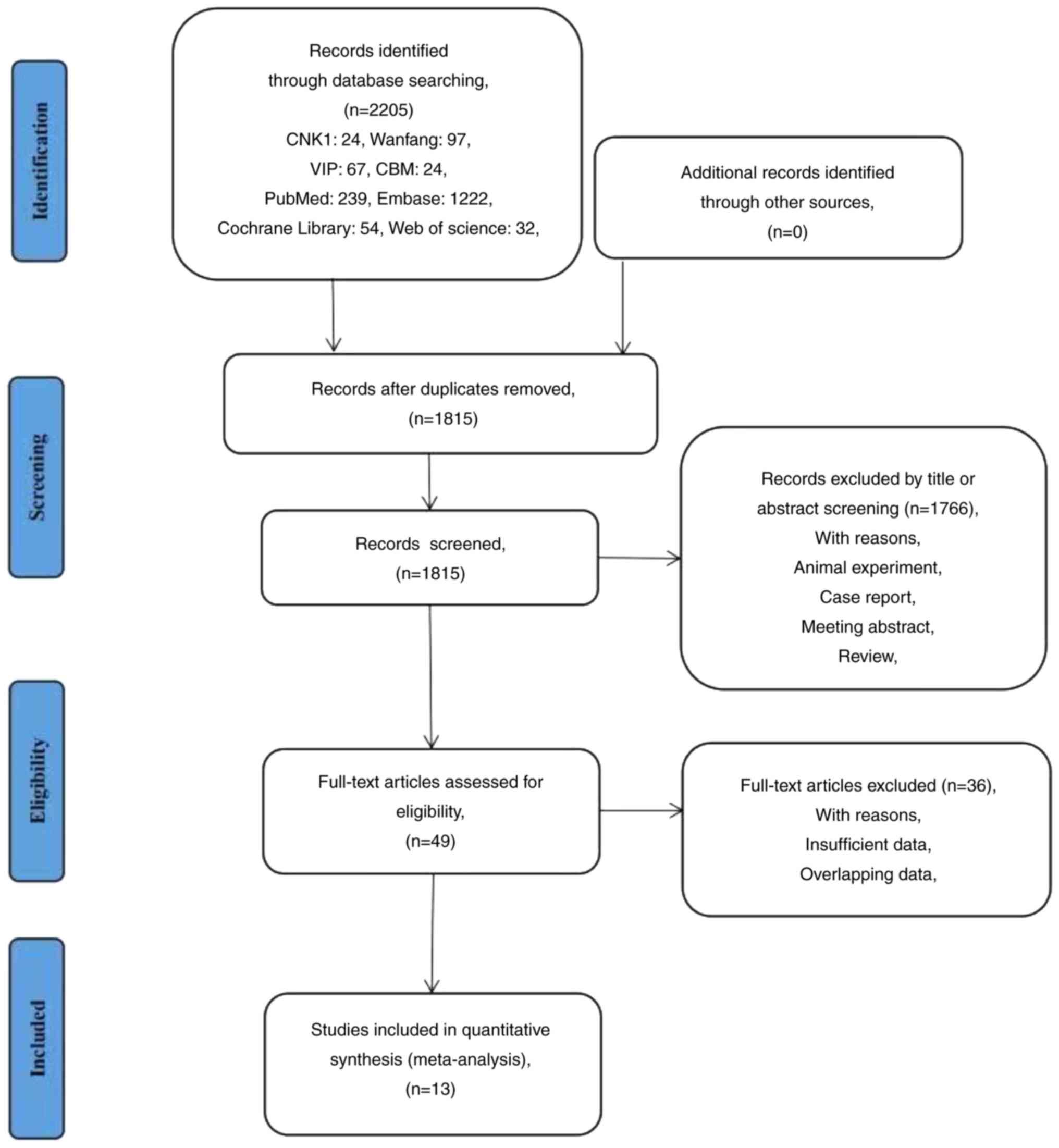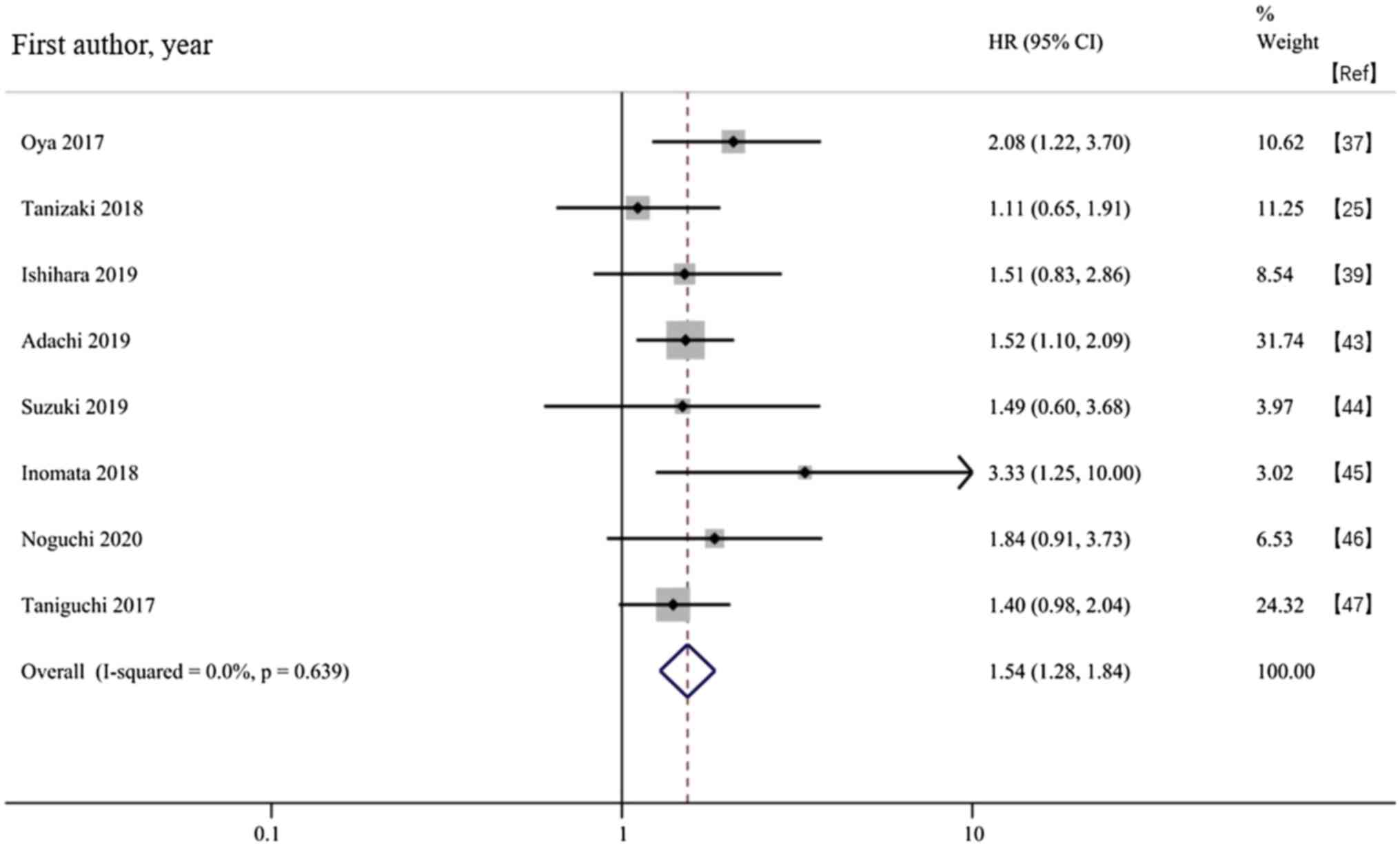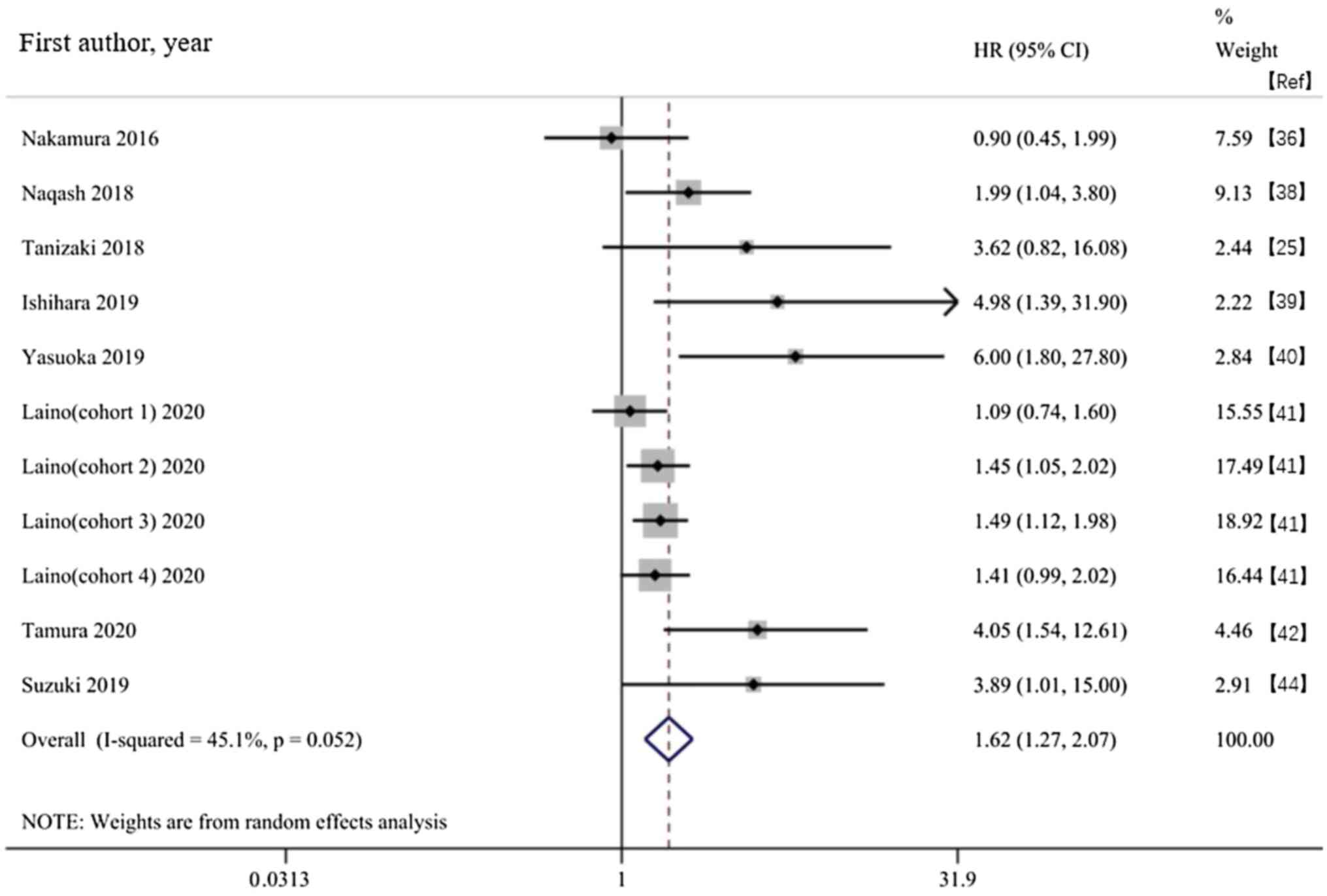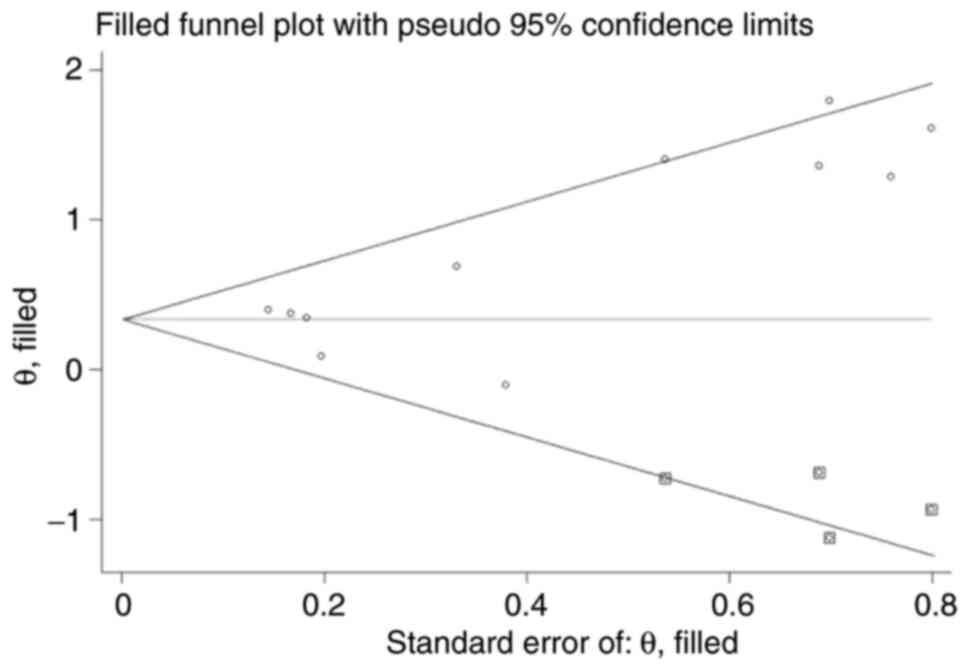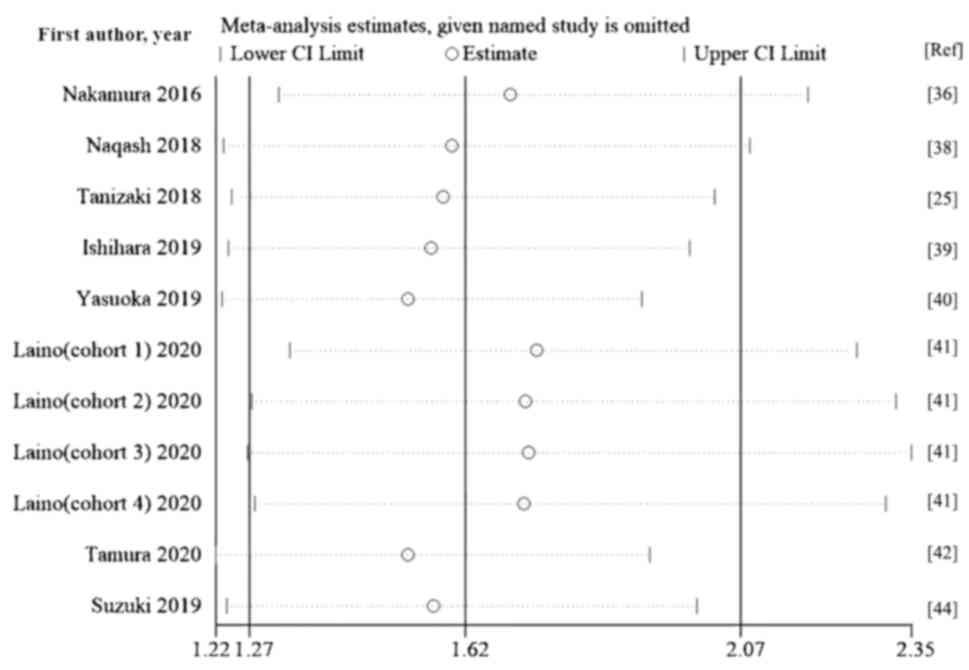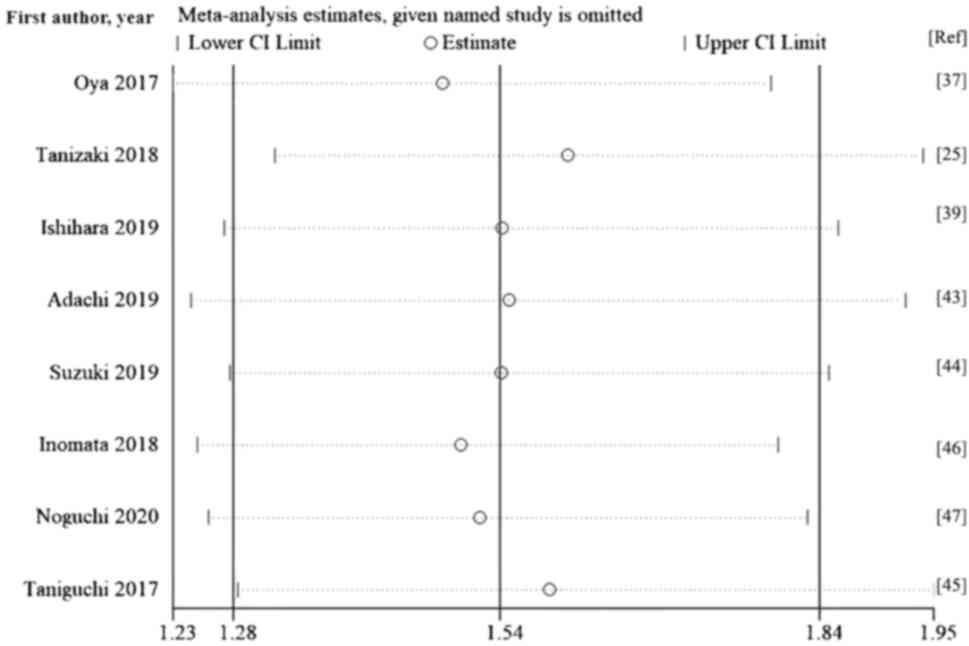Association between baseline C‑reactive protein level and survival outcomes for cancer patients treated with immunotherapy: A meta‑analysis
- Authors:
- Published online on: June 8, 2023 https://doi.org/10.3892/etm.2023.12060
- Article Number: 361
-
Copyright: © Xu et al. This is an open access article distributed under the terms of Creative Commons Attribution License.
Abstract
Introduction
Cancer seriously affects health and is responsible for the death of most people worldwide; there were an estimated 19.3 millon new cases and 10 million cancer deaths worldwide in 2020(1). In recent years, immunotherapy has emerged as a novel treatment option for advanced tumors (2). Current research hotspots include immune checkpoint inhibitors (ICIs) and multiple ICIs have shown clinical benefits for treatment of certain advanced cancers. However, factors such as low response rate, disease pseudoprogression and immune-associated adverse events require the identification of predictive and prognostic biomarkers to determine which patients may benefit from cancer immunotherapy (3). Histological markers such as programmed death-ligand 1 (PD-L1) expression, tumor mutation burden (TMB), microsatellite instability (MSI) and T cell receptors (TCRs) are currently well-known predictive biomarkers but they still present some limitations in clinical application and in predicting the efficacy of ICIs (4).
There are several cut-off criteria and antibodies for the PD-L1 expression analysis. For example, in cohort studies on PD-L1 inhibitors, such as durvalumab (5) and atezolizumab (6) SP163 and SP142 antibodies were used to evaluate the expression of PD-L1. However, in cohort studies on PD-1 inhibitors, such as nivolumab (7) and pembrolizumab (8), 28-8 and 22C3 antibodies were used (9). On the other hand, bias in defining positivity for PD-L1 expression could be observed among different cohort studies because of different cut-off values ranging from 1-50% (10). Secondly, several limitations exist on the clinical application of TMB for predicting the efficacy of ICIs. For example, different cohort studies use different TMB cut-off values (11-14) Although pembrolizumab was approved by the US Food and Drugs Administration (FDA) for use in patients with high TMB (TMB-H) solid tumors (≥10 mutations/megabase), contradictory results are observed in clinical practice (15). A previous study showed that patients with TMB-H had a low response rate to ICIs, while patients with low TMB values benefit from ICI therapies (16). Thirdly, although high MSI (MSI-H) is approved by FDA as a biomarker for predicting the efficacy of pembrolizumab in the treatment of solid tumors regardless of tumor histology, a contradictory phenomenon remains observable in clinical practice: For example, several studies suggest that patients with colorectal cancer with microsatellite stability (MSS) can also have a notable clinical response to PD-1 inhibitors (17,18).
By contrast, hematological markers are a focus of clinical research due to their several advantages including affordability, convenience and non-invasiveness. However, hematological markers have some limitations. For example, TCR plays important role in recognizing neoantigens, a prerequisite of T cell antitumor response. It was demonstrated that increased richness of TCR clonotypes is correlated with increased overall survival (OS) time in patients with melanoma treated with ipilimumab (19). This beneficial phenomenon could also be observed in patients with urothelial carcinoma treated with atezolizumab, in which long-term clinical benefits were significantly correlated with expansion of TCR (20). However, contradictory results were observed with anti-PD-1 therapy (21). Due to the heterogeneity of TCRs and the need for complicated analytical techniques, such as high-throughput sequencing and single-cell sequencing techniques, the clinical application for predicting the efficacy of ICIs is premature. Therefore, exploring other clinically available and accessible hematological markers is important. It was reported that inflammatory responses are associated with apoptosis inhibition, angiogenesis promotion and DNA damage, which result in tumor progression (22). Routine detection of multiple indicators in peripheral blood can reflect the inflammatory status of patients with cancer. C-reactive protein (CRP), as a marker of systemic inflammation, can predict the survival outcomes of patients with cancer treated with ICIs. A previous report showed that increased CRP was a marker of poor prognosis in patients with cancer who were treated with ICIs, which was associated with shortened progression-free survival (PFS) and OS times (23). Although several studies investigated the association between CRP levels and ICI therapy survival outcomes, different conclusions were found in these studies: For example, among patients with advanced melanoma who were treated with nivolumab, increased CRP levels were significantly associated with poor OS and PFS (24). By contrast, in patients with non-small cell lung cancer (NSCLC) who were treated with nivolumab, CRP was not correlated with PFS or OS (25). For ICIs other than nivolumab, the association between CRP and ICI therapy survival outcomes remains contradictory. For example, Muto et al (26) found that in patients with advanced melanoma, CRP is not associated with the efficacy of ipilimumab and OS; however, Shibata et al (27) found that in patients with advanced NSCLC, increased serum CRP levels at 6 weeks of treatment could predict longer survival when pembrolizumab was given as first-line treatment.
Therefore, the present meta-analysis aimed to explore the association between baseline CRP levels and survival outcomes of patients with cancer who were treated with ICIs to provide a basis for improved evaluation of the prognosis.
Materials and methods
Literature search
Electronic databases, including PubMed, EMbase, Cochrane Library, Web of Science, Chinese National Knowledge Infrastructure, WanFang, Chinese Literature Biomedical Database and Weipu Database (28) were searched to identify cohort studies on the relationship between baseline CRP levels and ICI survival outcomes from inception to November 2020. The key words used for the literature search were: ‘C-reactive protein’, ‘C reactive protein’, ‘CRP’, ‘neoplasms’, ‘tumors’, ‘cancers’, ‘carcinoma’, ‘immunotherapy’, ‘immune checkpoint inhibitor’, ‘PD-1 inhibitor’, ‘PD-L1 inhibitor’, ‘CTLA-4 inhibitor’, ‘nivolumab’, ‘pembrolizumab’, ‘atezolizumab’, ‘durvalumab’ and ‘ipilimumab’. In addition, the references of relevant articles were reviewed to identify potentially eligible studies.
Eligibility criteria
The inclusion criteria were as follows: i) Eligible patients were pathologically diagnosed with solid tumor and treated with ICIs alone or ICIs combined with systemic chemotherapy; ii) reported baseline CRP levels before treatment; iii) provided hazard ratios (HRs) and 95% CIs for baseline CRP levels and OS or PFS analysis or the data necessary to calculate them. When duplicated data were reported in different studies, only the most recent or highest quality were included.
The exclusion criteria were as follows: i) Reviews, comment letters, meeting abstracts or case reports; ii) in vivo or in vitro studies; iii) studies published in a language other than Chinese or English; iv) immunotherapy regimens other than ICIs; v) full text was not available or did not provide all necessary data mentioned in the inclusion criteria above; vi) provided post-treatment CRP levels or dynamic changes in CRP levels only.
Data extraction
A total of two authors independently reviewed and extracted data from the included studies. Any discrepancy was resolved through discussion with a third author. The data extracted from the eligible studies included the following items: i) Name of the first author(s) and year of publication; ii) patient median age and sex ratio; iii) sample size and types of cancer and ICI drug; iv) CRP cut-off values; v) HR and 95% CI associated with OS and PFS. The HRs from multivariate Cox analysis were top-priority for use when reported.
Quality assessment
The quality assessment of studies was conducted by two independent researchers according to the Newcastle-Ottawa Scale (NOS) (29), which assesses the quality based on three aspects: i) Selection of study subjects; ii) comparability between groups; and iii) measurement of outcomes. The maximum score was 9 points and studies scoring ≥6 points were regarded as high-quality studies.
Statistical analysis
Meta-analysis was conducted using STATA software (version 14.0; StataCorp,). The HR and corresponding 95% CI were used to evaluate the association between CRP and ICI survival outcomes in patients with cancer. Q test was performed to assess heterogeneity of included studies and the I2 statistic was calculated to evaluate the total observed variability due to study heterogeneity. I2>50% and/or P<0.1 was considered to indicate statistically significant heterogeneity (30). Subgroup analysis was performed to identify the source of heterogeneity. A random-effects model was chosen for the meta-analysis if there was significant heterogeneity between studies; otherwise, a fixed-effects model was selected (31). Sensitivity analysis was performed by excluding each study individually to assess the stability of the results (32). Publication bias was assessed using Egger's and Begg's tests, and P<0.05 was considered to indicate a significant publication bias (33,34). When significant publication bias was found, Duval and Tweedie's trim and fill method was used to calculate the effect of potential data censoring or publication bias on the outcomes of the meta-analysis (35).
Results
Characteristics of the included studies
A total of 2,205 relevant studies were identified through a systematic literature search. Firstly, 390 duplicate publications were excluded, while 1,766 were excluded after screening the titles and abstracts, including reviews, meeting abstracts, laboratory studies and other articles irrelevant to the present meta-analysis. Among them, 739 articles did not report survival risks, 954 articles did not involve patients using ICI and 73 articles were case reports that did not have sufficient data.
After reviewing and screening the full text of the remaining 49 articles, 36 additional articles were excluded according to the aforementioned inclusion and exclusion criteria. Finally, 13 retrospective studies were included in the present meta-analysis (25,36-47). The search process is shown in Fig. 1. All included studies were published between 2016 and 2020. A total of 2,387 patients were included in the present meta-analysis, while the sample sizes ranged from 36-313 participants. Patients were primarily diagnosed with NSCLC (6/13; 46.2%), melanoma (2/13; 15.4%), renal cell carcinoma (3/13; 23.1%) and urothelial carcinoma (2/13; 15.4%). The applications of ICI include anti-CTLA-4, anti-PD-1 and anti-CTLA-4 combined with anti-PD-1 inhibitors. The proportion of males was 53-87% in each study, and the mean age was 59-70 years. Regarding prognostic indicators of baseline CRP levels in patients receiving ICIs, three articles reported OS and PFS, five reported OS only and five reported PFS only. The CRP cut-off values were between 3 and 50 mg/l and the value of 10 mg/l was used frequently. The NOS scores of the included studies ranged from 5-7. The baseline characteristics of included studies are shown in Table I; other characteristics, including study design, country, study period and adjusted covariates, are listed in Table SI.
Survival outcome. Association between the baseline CRP and OS in patients receiving ICIs
Of the 13 included studies, eight provided the baseline CRP and OS. The random effects model showed a significant association between high baseline CRP levels and shortened OS time in patients receiving ICIs (HR, 1.62; 95% CI, 1.27-2.07; P<0.001; Fig. 2). The subgroup analysis based on type of cancer found that a high baseline CRP in patients with multiple cancer types treated with ICIs was associated with a poor OS. Subgroup analysis based on the CRP cut-off value of 10 mg/l showed that an increased baseline CRP was associated with poor OS regardless of whether the CRP levels were >10 mg/l; prognosis of patients with CRP ≥10 mg/l was worse (Table II).
Association between the baseline CRP and PFS in patients receiving ICIs. A total of eight studies evaluated PFS outcomes. The fixed-effects model meta-analysis showed that an increased baseline CRP was associated with a shorter PFS time in patients treated with ICIs (HR, 1.54; 95% CI, 1.28-1.84; P<0.001; Fig. 3). The subgroup analysis stratified by cancer type showed consistent results with OS, indicating that a high baseline CRP in patients with multiple cancer types treated with ICIs was associated with a poor PFS time. The subgroup analysis stratified by the CRP cut-off value showed that CRP≥10 mg/l was associated with poor PFS. Although HR values of PFS corresponding to CRP <10 mg/l were high, the difference was not statistically significant (Table III).
Sensitivity analysis
A sensitivity analysis was performed by excluding each study individually. The pooled HR values of the remaining studies ranged from 1.53-1.74 for OS and 1.48-1.60 for PFS, and the lower and upper thresholds of the 95% CI were >1. The exclusion of any study from the meta-analysis did not significantly change the summary estimate, showing that the results were not driven by any single study. The pooled HRs for OS and PFS were robust and the present meta-analysis was reliable (Figs. 4 and 5)
Publication bias
Begg's test funnel plot was drawn for the increased baseline CRP and the outcome indicators of OS and PFS. The scatter points were symmetrical, indicating a small possibility of publication bias (OS, P=0.087; PFS, P=0.174). Egger's test confirmed no publication bias in studies reporting the association between baseline CRP levels and PFS (P=0.233), but the analysis of the association between baseline CRP and OS suggested significant publication bias (P=0.012).
The trim and fill methods were used to evaluate the effect of publication bias on the meta-analysis outcomes. After trimming and filling, the scatter points were symmetrical in the funnel plot, indicating no publication bias (Fig. 6). For the pooled HRs for OS before and after trimming and filling, the fixed effect model were 1.493 (95% CI, 1.282-1.738; P<0.001) and 1.398 (95% CI, 1.206-1.621; P<0.001), and in the random effects model were 1.624 (95% CI, 1.272-2.074; P<0.001) and 1.410 (95% CI, 1.068-1.863; P=0.016), respectively. After eliminating the influence of publication bias, the result did not change significantly, suggesting that publication bias had little effect on the results of the meta-analysis.
Discussion
Inflammation is associated with all stages of cancer development and increased levels of systemic inflammation are associated with poor survival in patients with solid tumors (48). CRP is an acute-phase serum protein synthesized by hepatocytes and its expression is significantly increased in inflammatory disease (49). Moreover, CRP is associated with the prognosis of various cancer types (50). The association between cancer prognosis and serum CRP levels may be due to tumorigenesis that leads to increased CRP, which in turn promotes tumor progression. Tumor cells can produce CRP themselves and may produce and release cytokines and chemokines, such as IL-6 and IL-8, which increase the serum CRP concentration. Tumor growth and invasion cause tissue inflammation, leading to an increase in CRP levels. The innate and adaptive immune systems may respond to tumor antigens by increasing CRP levels (51). In addition, CRP induces DNA damage and weakens the immune system, thereby promoting carcinogenesis and tumor progression (22).
The present study analyzed current clinical evidence to assess the prognostic value of baseline CRP levels in patients with cancer in the context of immunotherapy. The meta-analysis showed that increased baseline CRP levels were associated with poor survival in patients with cancer treated with ICIs. Retrospective analyses by Tong et al (52) and Minichsdorfer et al (53) showed that increased baseline CRP levels were associated with shorter median PFS and OS in patients receiving immunotherapy. The present meta-analysis combined PFS and OS to provide improved evidence for clarifying the association between baseline CRP levels and prognosis in patients with advanced cancer receiving immunotherapy. However, certain studies showed opposite results, suggesting that an increased CRP was not associated with decreased OS and PFS in patients with melanoma and NSCLC treated with immunotherapy (35,36). This disagreement may be due to the lower number of patients with retrospective data, and different CRP level cut-off values used in those studies. There is no uniform standard for the CRP cut-off value, but a previous study suggested that the optimal cut-off value for CRP as a prognostic marker is 10 mg/l, which was also the upper limit of normal for CRP in most studies (23).
The present subgroup analysis based on cancer type found that the elevated baseline CRP was associated with poor survival outcomes in multiple cancers. Using two independent multicenter real-world cohorts (discovery and validation cohorts), Iivanainen et al (23) found that the elevated baseline CRP was correlated with shortened OS and PFS among patients treated with PD-1/PD-L1 in both cohorts. In the present subgroup analysis based on cancer type, the association between increased baseline CRP levels with survival outcomes was significant in melanoma (two cohorts) and NSCLC (validation cohort). Although not statistically significant, a trend consistent with the general population was also observed in renal cell and urothelial carcinoma, as well as with other cancer types, which indicates the elevated baseline CRP was correlated with poor OS and PFS times. Survival differences were similar among all the studies (23). In the current meta-analysis, the subgroup analysis based on the CRP cut-off value of 10 mg/l found that both PFS and OS reported higher mortality risk in patients with CRP ≥10 mg/l. CRP <10 mg/l was also associated with poor OS, although the corresponding HR value for PFS was increased and the difference was not statistically significant. This may be due to the small number of studies with CRP <10 mg/l included in the PFS analysis. A larger number of high-quality studies should be included in the future to evaluate the impact of CRP cut-off values on the prognosis of patients treated with ICIs and CRP cut-off levels should be further validated in future clinical applications. CRP levels may reflect a specific biological tumor characteristic associated with insensitivity to immunotherapy, which would prompt physicians to use a therapeutic strategy targeting CRP in combination with ICIs. A recent study showed that blocking synthesis and/or activity of CRP in combination with ICIs improves response and survival in patients with melanoma (41). Larger studies are needed to find the best immunotherapy strategy. The present study had limitations. All the included studies were retrospective with several confounding factors; moreover, the number of studies and the sample size were limited, which may lead to potential bias. Furthermore, the included studies were heterogeneous in terms of CRP cut-off values and ICI drugs. The present meta-analysis only focused on the association between baseline CRP levels and prognosis; the impact of post-treatment CRP and dynamic changes in CRP on survival outcomes should be further considered. Finally, although the trim and fill method confirmed the results, there was some publication bias.
In summary, the current evidence suggested that compared with patients with low baseline CRP levels, increased baseline CRP levels were associated with poor OS and PFS in patients receiving ICIs. Furthermore, a CRP≥10 mg/l indicated a worse prognosis. Therefore, baseline CRP levels might serve as a marker for the prognosis of patients with certain solid tumors treated with ICIs. Due to the limited quality and quantity of the included studies, a larger number of prospective well-designed studies are required to verify the present findings.
Supplementary Material
Detailed information of studies included in meta-analysis.
Acknowledgements
Not applicable.
Funding
Funding: No funding was received.
Availability of data and materials
The datasets used and/or analyzed during the current study are available from the corresponding author on reasonable request.
Authors' contributions
YX, JYW and KM conceived and designed the study. YX, KM, FZ and MTM performed the experiments. LH, SJW, SPL, JYW and PPS analyzed data and drafted the manuscript. JYW and SJW prepared the figures. SJW, KM and PPS edited the manuscript. YX, JYW and SJW confirm the authenticity of all the raw data. All authors have read and approved the final manuscript.
Ethics approval and consent to participate
Not applicable.
Patient consent for publication
Not applicable.
Competing interests
The authors declare that they have no competing interests.
References
|
Sung H, Ferlay J, Siegel RL, Laversanne M, Soerjomataram I, Jemal A and Bray F: Global cancer statistics 2020: GLOBOCAN estimates of incidence and mortality worldwide for 36 cancers in 185 countries. CA Cancer J Clin. 71:209–249. 2021.PubMed/NCBI View Article : Google Scholar | |
|
Duan J, Cui L, Zhao X, Bai H, Cai S, Wang G, Zhao Z, Zhao J, Chen S, Song J, et al: Use of immunotherapy with programmed cell death 1 vs programmed cell death ligand 1 inhibitors in patients with cancer: A systematic review and meta-analysis. JAMA Oncol. 6:375–384. 2020.PubMed/NCBI View Article : Google Scholar | |
|
de Miguel M and Calvo E: Clinical challenges of immune checkpoint inhibitors. Cancer Cell. 38:326–333. 2020.PubMed/NCBI View Article : Google Scholar | |
|
Ma K, Jin Q, Wang M, Li X and Zhang Y: Research progress and clinical application of predictive biomarker for immune checkpoint inhibitors Expert Rev Mol. Diagn. 19:517–529. 2019.PubMed/NCBI View Article : Google Scholar | |
|
Powles T, van der Heijden MS, Castellano D, Galsky MD, Loriot Y, Petrylak DP, Ogawa O, Park SH, Lee JL, Giorgi UD, et al: Durvalumab alone and durvalumab plus tremelimumab versus chemotherapy in previously untreated patients with unresectable, locally advanced or metastatic urothelial carcinoma (DANUBE): A randomised, open-label, multicentre, phase 3 trial. Lancet Oncol. 21:1574–1588. 2020.PubMed/NCBI View Article : Google Scholar | |
|
Felip E, Altorki N, Zhou C, Csőszi T, Vynnychenko I, Goloborodko O, Luft A, Akopov A, Martinez-Marti A, Kenmotsu H, et al: Adjuvant atezolizumab after adjuvant chemotherapy in resected stage IB-IIIA non-small-cell lung cancer (IMpower010): A randomised, multicentre, open-label, phase 3 trial. Lancet. 398:1344–1357. 2021.PubMed/NCBI View Article : Google Scholar | |
|
Weber JS, D'Angelo SP, Minor D, Hodi FS, Gutzmer R, Neyns B, Hoeller C, Khushalani NI, Miller WH Jr, Lao CD, et al: Nivolumab versus chemotherapy in patients with advanced melanoma who progressed after anti-CTLA-4 treatment (CheckMate 037): A randomised, controlled, open-label, phase 3 trial. Lancet Oncol. 16:375–384. 2015.PubMed/NCBI View Article : Google Scholar | |
|
Brahmer JR, Rodríguez-Abreu D, Robinson AG, Hui R, Csőszi T, Fülöp A, Gottfried M, Peled N, Tafreshi A, Cuffe S, et al: Health-related quality-of-life results for pembrolizumab versus chemotherapy in advanced, PD-L1-positive NSCLC (KEYNOTE-024): A multicentre, international, randomised, open-label phase 3 trial. Lancet Oncol. 18:1600–1609. 2017.PubMed/NCBI View Article : Google Scholar | |
|
Hutarew G: PD-L1 testing, fit for routine evaluation? From a pathologist's point of view. Memo. 9:201–206. 2016.PubMed/NCBI View Article : Google Scholar | |
|
Lisberg A and Garon EB: The value of PD-L1 testing in non-small-cell lung cancer. JAMA Oncol. 2:571–572. 2016.PubMed/NCBI View Article : Google Scholar | |
|
Jardim DL, Goodman A, de Melo Gagliato D and Kurzrock R: The challenges of tumor mutational burden as an immunotherapy biomarker. Cancer Cell. 39:154–173. 2021.PubMed/NCBI View Article : Google Scholar | |
|
David PC, Reck M, Luis PA, Creelan B, Horn L, Steins M, Felip E, van den Heuvel MM, Ciuleanu TE, Badin F, et al: First-line nivolumab in stage IV or recurrent non-small-cell lung cancer. N Engl J Med. 376:2415–2426. 2017.PubMed/NCBI View Article : Google Scholar | |
|
Hellmann MD, Nathanson T, Rizvi H, Creelan BC, Sanchez-Vega F, Ahuja A, Ni A, Novik JB, Mangarin LMB, Abu-Akeel M, et al: Genomic features of response to combination immunotherapy in patients with advanced non-small-cell lung cancer. Cancer Cell. 33:843–852.e4. 2018.PubMed/NCBI View Article : Google Scholar | |
|
Alborelli I, Leonards K, Rothschild SI, Leuenberger LP, Prince SS, Mertz KD, Poechtrager S, Buess M, Zippelius A, Läubli H, et al: Tumor mutational burden assessed by targeted NGS predicts clinical benefit from immune checkpoint inhibitors in non-small cell lung cancer. J Pathol. 250:19–29. 2020.PubMed/NCBI View Article : Google Scholar | |
|
Marcus L, Fashoyin-Aje LA, Donoghue M, Yuan M, Rodriguez L, Gallagher PS, Philip R, Ghosh S, Theoret MR, Beaver JA, et al: FDA approval summary: Pembrolizumab for the treatment of tumor mutational burden-high solid tumors. Clin Cancer Res. 27:4685–4689. 2021.PubMed/NCBI View Article : Google Scholar | |
|
Goodman A, Kato S, Bazhenova L, Patel SP, Frampton GM, Miller V, Stephens PJ, Daniels GA and Kurzrock R: Tumor mutational burden as an independent predictor of response to immunotherapy in diverse cancers. Mol Cancer Ther. 16:2598–2608. 2017.PubMed/NCBI View Article : Google Scholar | |
|
Palles C, Cazier JB, Howarth KM, Domingo E, Jones AM, Broderick P, Kemp Z, Spain SL, Guarino E, Salguero I, et al: Germline mutations in the proof-reading domains of POLE and POLD1 predispose to colorectal adenomas and carcinomas. Nat Genet. 45:136–144. 2013.PubMed/NCBI View Article : Google Scholar | |
|
Gong J, Wang C, Lee PP, Chu P and Fakih M: Response to PD-1 blockade in microsatellite stable metastatic colorectal cancer harboring a POLE mutation. J Natl Compr Canc Netw. 15:142–147. 2017.PubMed/NCBI View Article : Google Scholar | |
|
Postow MA, Manuel M, Wong P, Yuan J, Dong Z, Liu C, Perez S, Tanneau I, Noel M, Courtier A, et al: Peripheral T cell receptor diversity is associated with clinical outcomes following ipilimumab treatment in metastatic melanoma. J Immunother Cancer. 23:10.1186/s40425-015-0070-4. 2015.PubMed/NCBI View Article : Google Scholar | |
|
Snyder A, Nathanson T, Funt SA, Ahuja A, Novik JB, Hellmann MD, Chang E, Aksoy BA, Al-Ahmadie H, Yusko E, et al: Contribution of systemic and somatic factors to clinical response and resistance to PD-L1 blockade in urothelial cancer: An exploratory multi-omic analysis. PLoS Med. 14(e1002309)2017.PubMed/NCBI View Article : Google Scholar | |
|
Tumeh PC, Harview CL, Yearley JH, Shintaku IP, Taylor EJM, Robert L, Chmielowski B, Spasic M, Henry G, Ciobanu V, et al: PD-1 blockade induces responses by inhibiting adaptive immune resistance. Nature. 515:568–571. 2014.PubMed/NCBI View Article : Google Scholar | |
|
Gao GD, Sun B, Wang XB and Wang SM: Neutrophil to lymphocyte ratio as prognostic indicator for patients with esophageal squamous cell cancer. Int J Biol Markers. 32:e409–e414. 2017.PubMed/NCBI View Article : Google Scholar | |
|
Iivanainen S, Ahvonen J, Knuuttila A, Tiainen S and Koivunen JP: Elevated CRP levels indicate poor progression-free and overall survival on cancer patients treated with PD-1 inhibitors. ESMO Open. 4(e000531)2019.PubMed/NCBI View Article : Google Scholar | |
|
Chasseuil E, Saint-Jean M, Chasseuil H, Peuvrel L, Quéreux G, Nguyen JM, Gaultier A, Varey E, Khammari A and Dréno B: Blood predictive biomarkers for nivolumab in advanced melanoma. Acta Derm Venereol. 98:406–410. 2018.PubMed/NCBI View Article : Google Scholar | |
|
Tanizaki J, Haratani K, Hayashi H, Chiba Y, Nakamura Y, Yonesaka K, Kudo K, Kaneda H, Hasegawa Y, Tanaka K, et al: Peripheral blood biomarkers associated with clinical outcome in non-small cell lung cancer patients treated with nivolumab. J Thorac Oncol. 13:97–105. 2018.PubMed/NCBI View Article : Google Scholar | |
|
Muto Y, Kitano S, Tsutsumida A, Namikawa K, Takahashi A, Nakamura Y, Yamanaka T, Yamamoto N and Yamazaki N: Investigation of clinical factors associated with longer overall survival in advanced melanoma patients treated with sequential ipilimumab. J Dermatol. 46:498–506. 2019.PubMed/NCBI View Article : Google Scholar | |
|
Shibata Y, Kato T, Shimokawaji T and Yamada K: P2.01-88 C-reactive protein (CRP) as a predictive marker for survival in patients with advanced NSCLC treated with first line Pembrolizumab Monotherapy. J Thorac Oncol. 10(13)2018. | |
|
Hernandez AV, Marti KM and Roman YM: Meta-analysis. Chest. 158:S97–S102. 2020.PubMed/NCBI View Article : Google Scholar | |
|
Stang A: Critical evaluation of the Newcastle-Ottawa scale for the assessment of the quality of nonrandomized studies in meta-analyses. Eur J Epidemiol. 25:603–605. 2010.PubMed/NCBI View Article : Google Scholar | |
|
Higgins JPT, Thompson SG, Deeks JJ and Altman DG: Measuring inconsistency in meta-analyses. BMJ. 327:557–560. 2003.PubMed/NCBI View Article : Google Scholar | |
|
DerSimonian R and Laird N: Meta-analysis in clinical trials. Control Clin Trials. 7:177–188. 1986.PubMed/NCBI View Article : Google Scholar | |
|
O'Rourke K, Shea B and Wells GA: Meta-analysis of clinical trials(M)//Applied Statistics in the Pharmaceutical Industry. Springer, New York, NY, pp397-424, 2001. | |
|
Egger M, Smith GD, Schneider M and Minder C: Bias in meta-analysis detected by a simple, graphical test. BMJ. 315:629–634. 1997.PubMed/NCBI View Article : Google Scholar | |
|
Begg CB and Mazumdar M: Operating characteristics of a rank correlation test for publication bias. Biometrics. 50:1088–1101. 1994.PubMed/NCBI | |
|
Duval S and Tweedie R: Trim and fill: A simple funnel-plot-based method of testing and adjusting for publication bias in meta-analysis. Biometrics. 56:455–463. 2000.PubMed/NCBI View Article : Google Scholar | |
|
Nakamura Y, Kitano S, Takahashi A, Tsutsumida A, Namikawa K, Tanese K, Abe T, Funakoshi T, Yamamoto N, Amagai M and Yamazaki N: Nivolumab for advanced melanoma: pretreatment prognostic factors and early outcome markers during therapy. Oncotarget. 7:77404–77415. 2016.PubMed/NCBI View Article : Google Scholar | |
|
Oya Y, Yoshida T, Kuroda H, Mikubo M, Kondo C, Shimizu J, Horio Y, Sakao Y, Hida T and Yatabe Y: Predictive clinical parameters for the response of nivolumab in pretreated advanced non-small-cell lung cancer. Oncotarget. 8:103117–103128. 2017.PubMed/NCBI View Article : Google Scholar | |
|
Naqash AR, Stroud CRG, Butt MU, Dy GK, Hegde A, Muzaffar M, Yang LV, Hafiz M, Cherry CR and Walker PR: Co-relation of overall survival with peripheral blood-based inflammatory biomarkers in advanced stage non-small cell lung cancer treated with anti-programmed cell death-1 therapy: Results from a single institutional database. Acta Oncologica. 57:867–872. 2018.PubMed/NCBI View Article : Google Scholar | |
|
Ishihara H, Tachibana H, Takagi T, Kondo T, Fukuda H, Yoshida K, Iizuka J, Kobayashi H, Okumi M, Ishida H and Tanabe K: Predictive impact of peripheral blood markers and C-reactive protein in nivolumab therapy for metastatic renal cell carcinoma. Target Oncol. 14:453–463. 2019.PubMed/NCBI View Article : Google Scholar | |
|
Yasuoka S, Yuasa T, Nishimura N, Ogawa M, Komai Y, Numao N, Yamamoto S, Kondo Y and Yonese J: Initial experience of pembrolizumab therapy in Japanese patients with metastatic urothelial cancer. Anticancer Res. 39:3887–3892. 2019.PubMed/NCBI View Article : Google Scholar | |
|
Laino AS, Woods D, Vassallo M, Qian X, Tang H, Wind-Rotolo M and Weber J: Serum interleukin-6 and C-reactive protein are associated with survival in melanoma patients receiving immune checkpoint inhibition. J Immunother Cancer. 8(e000842)2020.PubMed/NCBI View Article : Google Scholar | |
|
Tamura D, Jinnouchi N, Abe M, Ikarashi D, Matsuura T, Kato R, Maekawa S, Kato Y, Kanehira M, Takata R and Obara W: Prognostic outcomes and safety in patients treated with pembrolizumab for advanced urothelial carcinoma: Experience in real-world clinical practice. Int J Clin Oncol. 25:899–905. 2020.PubMed/NCBI View Article : Google Scholar | |
|
Adachi Y, Tamiya A, Taniguchi Y, Enomoto T, Azuma K, Kouno S, Inagaki Y, Saijo N, Okishio K and Atagi S: Predictive factors for progression- free survival in non-small cell lung cancer patients receiving nivolumab based on performance status. Cancer Med. 9:1383–1391. 2020.PubMed/NCBI View Article : Google Scholar | |
|
Suzuki K, Terakawa T, Furukawa J, Harada K, Hinata N, Nakano Y and Fujisawa M: C-reactive protein and the neutrophil-to-lymphocyte ratio are prognostic biomarkers in metastatic renal cell carcinoma patients treated with nivolumab. Int J Clin Oncol. 25:135–144. 2020.PubMed/NCBI View Article : Google Scholar | |
|
Inomata M, Hirai T, Seto Z, Tokui K, Taka C, Okazawa S, Kambara K, Ichikawa T, Imanishi S, Yamada T, et al: Clinical parameters for predicting the survival in patients with squamous and non-squamous-cell NSCLC receiving PD-1 inhibitor therapy. Pathol Oncol Res. 26:327–333. 2018.PubMed/NCBI View Article : Google Scholar | |
|
Noguchi G, Nakaigawa N, Umemoto S, Kobayashi K, Shibata Y, Tsutsumi S, Yasui M, Ohtake S, Suzuki T, Osaka K, et al: C-reactive protein at 1 month after treatment of nivolumab as a predictive marker of efficacy in advanced renal cell carcinoma. Cancer Chemother Pharmacol. 86:75–85. 2020.PubMed/NCBI View Article : Google Scholar | |
|
Taniguchi Y, Tamiya A, Isa SI, Nakahama K, Okishio K, Shiroyama T, Suzuki H, Inoue T, Tamiya M, Hirashima T, et al: Predictive factors for poor progression-free survival in patients with non-small cell lung cancer treated with nivolumab. Anticancer Res. 37:5857–5862. 2017.PubMed/NCBI View Article : Google Scholar | |
|
Roxburgh CSD and McMillan DC: Role of systemic inflammatory response in predicting survival in patients with primary operable cancer. Future Oncol. 6:149–163. 2010.PubMed/NCBI View Article : Google Scholar | |
|
Yoshida T, Ichikawa J, Giuroiu I, Laino AS, Hao Y, Krogsgaard M, Vassallo M, Woods DM, Hodi FS and Weber J: C reactive protein impairs adaptive immunity in immune cells of patients with melanoma. J Immunother Cancer. 8(e000234)2020.PubMed/NCBI View Article : Google Scholar | |
|
Shrotriya S, Walsh D, Bennani-Baiti N, Thomas S and Lorton C: C-reactive protein is an important biomarker for prognosis tumor recurrence and treatment response in adult solid tumors: A systematic review. PLoS One. 10(e0143080)2015.PubMed/NCBI View Article : Google Scholar | |
|
Li W, Luo X, Liu Z, Chen Y and Li Z: Prognostic value of C-reactive protein levels in patients with bone neoplasms: A meta-analysis. PLoS One. 13(e0195769)2018.PubMed/NCBI View Article : Google Scholar | |
|
Tong MT: A retrective cohort study to explore the correlaition between peripheral blood markers and survival in solid tumor treated with Atezolizumab monotheraphy (unpublished PhD thesis). Zhejiang University, 2018. | |
|
Minichsdorfer C, Gleiss A, Aretin MB, Schmidinger M and Fuereder T: 124P Serum parameters as prognostic biomarkers for anti PD-1/PD-L1 therapy in patients with solid tumours: A retrospective data analysis. Ann Oncol. 31:S289–S290. 2020. |



